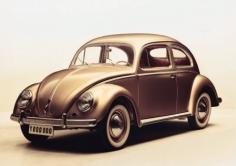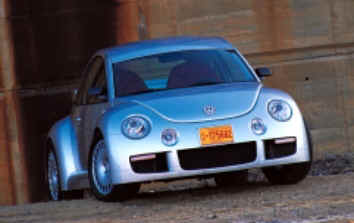
.
. .
..
. . .
© 1998
- 2005 Copyright & |
Volkswagen in America : On the road for 50 years
Years later, in Germany, Ferdinand Porsche created what was designed to
be a "people’s car" - the Volkswagen. This small sedan, which became
affectionately known as the "Beetle" went on to make automotive history,
becoming the most popular mass mobility car of all time
The first Volkswagen Beetle was shipped to the United States by Dutch importer Ben Pon, arriving in New York in January of 1949. It was one of just two Volkswagens sold that year, as most Americans were unaware of such a creation and inherently distrustful of foreign cars in the first place. Volkswagen sales grew steadily - by the end of 1953, a total of 1,214 Volkswagens were traveling America’s streets. Volkswagen, as a foreign carmaker, was not alone in facing the challenge of creating a presence for itself in America. By the end of World War II, when it came to car purchases, Americans were skeptical of most foreign cars. A foreign import car was not only a luxury, it was also considered a risk, as major repairs could be difficult, if not impossible. To think that a small, strange-looking German car could compete with the high volume domestics would have seemed absurd in the early 50's. In 1958, a convertible model was introduced which boosted sales to 18,000. Sales peeked in the late 1960s when Volkswagen averaged about 33,000 annually. By 1961, production for Volkswagen hit the one-million milestone for the first time. The annual production rate in Japan drove Volkswagen’s production to this new high.
October 18, 1962 marked an important day in Volkswagen’s history. The new Volkswagen of America’s headquarters opened in Englewood Cliffs, New Jersey, and the one-millionth Volkswagen arrived in the United States.
With the Beetle’s success, Volkswagen found a concurrent market for a very different type of model - the Volkswagen Transporter, or as it was more commonly known, the "Microbus" or just plain "bus." The original Volkswagen "Microbus" was imported to the U.S. in 1950. Essentially the first passenger van, the "Microbus," was so revolutionary that Volkswagen had to market it as the Volkswagen station wagon model. At its peak in 1970, Volkswagen sold more than 65,000 vans.
During its time in the U.S., the Volkswagen Beetle became a part of American culture and an icon to people of all ages. However, by 1977 Beetle sales in the U.S. had dropped to below 20,000 (down from over 90,000 just two years earlier) as the cost of building the Beetle increased. 1977 marked the last model year for the sedan and 1979 for the convertible. Volkswagen, however, continued to build the Beetle in Mexico and sold it in some South American countries. Today it remains a popular car in Mexico, where its history making production totals some 21,500,000 (through 1998), adding to its status as the best selling car of all time.
In the middle of the 1990's, the Golf production exceeded that of the venerable Ford Model T to become the third most popular car of all time. The 1980s brought a new look to successful models, and innovative new designs to first-time models. In 1984, Volkswagen introduced the Jetta, a sedan based on the Rabbit, to the U.S., as well as the instantly classic Rabbit Convertible. The third generation of the Volkswagen Bus, known as the Vanagon, was also welcomed back to the market. As the economy boomed, families grew larger, and so did the need for greater space in vehicles. Volkswagen responded with its first midsize in 1982 with the Quantum, a larger, more upscale four-door family sedan. That same year, wind-tunnel design influenced the more rounded shapes that were built into the second generation Scirocco. During this decade, one of Volkswagen’s most popular cars was a sportier two-door Rabbit called simply, the GTI. It’s affordability, compact, but powerful four-cylinder engine performance and toss-about handling characteristics earned it nicknames, including "Pocket Rocket" and "Nickel Missile." A later version even became an award winner, as it was named Motor Trend "Car of the Year." In the mid-1980's, both the Rabbit and Jetta were further refined with a second-generation redesign. Both models were larger, more aerodynamic and better equipped, yet their fuel efficiency remained intact.
This attribute was also designed into Volkswagen’s larger cars such as the Quantum Wagon and Vanagon models, which were equipped with the new and advanced "Syncro" all-wheel drive system. While many Americans sought status cars in the 1980's, others still sought the unpretentious German engineered value and practicality inherent in Volkswagens. The Volkswagen Fox represented this appeal and became the late 1980's answer to the need for a spirited, fun, and compact sedan and wagon. The Fox was spacious for a small car, durable and, best of all, affordable. As the more frivolous days of the 1980's wound down, Volkswagen unveiled its largest passenger car to date: the 1990 Passat Sedan entered the marketplace as a fashionable new family car with Autobahn qualifications. For those drivers whose focus was still on performance, Volkswagen also introduced its first real sport car, Corrado, a 2-plus-2 which originally came equipped with an innovative four cylinder, and then three years later rocked the automotive world by offering Volkswagen’s first ever V6. The engine was called the Volkswagen VR6 because of its innovative compact design that allowed it to fit in almost the same space as a four-cylinder. 1995 welcomed a third generation of the venerable Volkswagen convertible and shortened the name from Cabriolet to simply, Cabrio. For the Passat, the year brought updated styling, as well as new standard equipment. It was an attractively priced, efficient performer. Its VR6 engine earned it the "Top-Ten Engines" award for 1995 from Ward’s Auto World and Great Britain’s Car Magazine. The New Beetle’s evocative styling - which was based on and first, began with the ultra popular design study called Concept 1 - instantly made it the most original car in the world. With a personality all its own, the New Beetle was designed to represent "optimism on wheels," as some have said. Today’s New Beetle owner, like most Volkswagen owners, loves to drive and isn’t shy about making a statement on the road. Since its debut, the New Beetle has propelled the brand forward and showed the world how far Volkswagen has progressed, while always remaining true to its simple and honest heritage. In many ways, it became an irresistible magnet to the Volkswagen brand, inviting people back to Volkswagen to recognize just how far the brand had come through the years. A totally redesigned Jetta entered the compact class market this year. It’s the fourth generation of Volkswagen’s best-selling model and North America’s most popular European nameplate. In design, performance, comfort and attention to detail, the new Jetta completely redefines the class where it resides by offering the previously unattainable qualities of a high-class European sedan.
New Beetle RSI version Today, as Volkswagen celebrates its 50th year of bringing cars to the U.S. in 1999, the New Beetle continues to excite automotive enthusiasts with many updates and the addition of a 1.8 liter, 20-valve, turbocharged four-cylinder engine. Like the original Beetle, the New Beetle GLX driving experience is unlike anything else on the road. It is the product of Volkswagen’s most advanced technology. The result is a car that rewards its driver with the performance and fun expected in a modern German-engineered car.
|
. |







